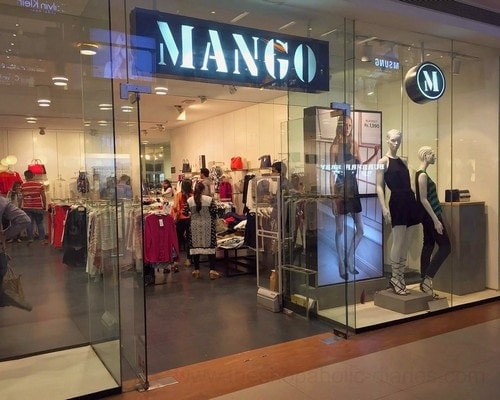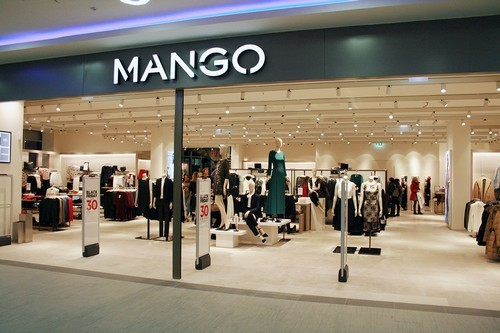The Marketing mix of Mango analyses the 4Ps of Mango, which include the Product, Price, Place, and Promotion of Mango. Punto Fa, S. L is commonly known by its trading name Mango. It is associated with the lifestyle and retail industry as it deals in apparel and accessories. The company is of Spanish origin and was founded in 1984 by its co-founders and brothers Nahman Andic and Isak Andic. Mango is an established fast-fashion brand known for its stylish apparel. It faces competition from the following-
- Bershka
- Zara
- Supreme
- Cos
- New Look
- French Connection
About Mango
- Type: Fashion retailer
- Industry: Retail
- Founded: 1984
- Founders: Isak Andic
- Headquarters: Barcelona, Spain
- Area served: Worldwide
- Current CEO: Toni Ruiz
- Number of employees: Over 11,000
- Major products: Women’s, men’s, and children’s clothing, accessories, and home goods
Table of Contents
Mango Product Strategy
Mango is a design and manufacturing company with products for kids, women, babies, and men. It has a unique product line that appeals to fashion-conscious people looking for something new and latest. The brand portfolio includes
Women
- Swimsuits and Bikinis
- Skirts
- Shorts
- Jeans
- Pants
- Coats
- Jackets
- Sweatshirts
- Sweaters and Cardigans
- Tops and T-Shirts
- Shirts
- Jumpsuits
- Dresses
- Belts
- Sunglasses
- Scarves
- Jewellery
- Cases and Wallets
- Bags
- Shoes
Girls
- Jewellery
- Bags
- Belts
- Shoes
- Swimwear
- Pyjamas and Underwear
- Skirts and Shirts
- Shorts
- Jeans and Pants
- Coats and Jackets
- Sweatshirts
- Sweaters and Cardigans
- T-Shirts
- Jumpsuits
- Dresses
Men
- Sunglasses
- Ties
- Belts
- Wallets
- Bags
- Footwear
- Underwear
- Swimwear
- Bermudas
- Jeans
- Pants
- Coats
- Leather
- Jackets
- Suits
- Blazers
- Sweatshirts
- Sweaters and Cardigans
- Polo Shirts
- T-shirts and Shirts
Boys
- Scarves
- Shoes
- Swimwear
- Pyjamas and Underwear
- Bermudas
- Jeans and Pants
- Coats and Jackets
- Sweatshirts
- Sweaters and Cardigans
- Polo Shirts
- T-Shirts and Shirts
The Mango fashion brand is known for its trendy and contemporary clothing and accessories.
The product mix of Mango in 2023 is as follows (Source)
- Women’s Clothing: This includes dresses, blouses, skirts, trousers, jeans, t-shirts, and outerwear like jackets and coats.
- Men’s Clothing: Offering a range of shirts, trousers, jeans, t-shirts, suits, and outerwear like jackets and blazers.
- Kids’ Clothing: A collection for children, including both casual and formal wear.
- Accessories: This encompasses many items like scarves, belts, hats, and gloves.
- Footwear: Offering shoes for men and women, including boots, flats, heels, and sneakers.
- Bags and Purses: Various styles, including handbags, tote bags, clutches, and wallets.
- Jewelry: Featuring necklaces, bracelets, earrings, and rings.
- Eyewear: A selection of sunglasses and prescription-compatible frames.
- Swimwear: Includes swimsuits, bikinis, and beachwear accessories for women.
- Lingerie and Sleepwear: Offering bras, panties, sleepwear, and loungewear.
- Sportswear: A range of athletic clothing and accessories for an active lifestyle.
- Beauty Products: This might include perfumes and other small beauty items.
- Home Accessories: Some Mango stores also offer candles, small decor pieces, and textiles.
It’s important to note that the specific offerings can vary by location and season, and Mango often updates its collections to stay in line with current fashion trends.
Mango Place Strategy
Mango is a global brand with an international presence. It started its journey from Barcelona in Spain and, with time, has spread its presence to Africa, Europe, Asia-Pacific, and the Americas to include countries like Turkey, Chile, Morocco, Nigeria, Argentina, Namibia, Poland, France, Germany, United States, Salvador, Greece, Hungary, Georgia, Romania, Pakistan, Canada, Sri Lanka, Armenia, Sweden, Istanbul, and Spain. Its headquarters is at Palau Solita i Piegamans in Barcelona, Spain. The company entered the Indian market in 2001 via its store in Delhi and has spread to several outlets, including a store in the metro city of Mumbai.
Mango has a strong and widespread distribution channel. It works via a network of nearly a thousand two hundred stores spread over one hundred and ten countries in the global arena. The brand is available in company-owned outlets and concession stores. Mango has adopted a franchise system, and its stores are opened under a franchise responsible for its upkeep. Stores are equipped with advanced technology and offer impeccable services to make the shopping experience seamless.
Mango realized the importance of online marketing and opened its website in 1995, and by the year 2000 had opened its first online e-store. E-tailor Myntra, who deals in various fashion brands, has bagged Mango’s management and distribution rights in India. The arrangement states that Myntra will facilitate the opening and managing twenty-five stores for the fashion brand Mango.
The brand will be displayed exclusively on Jabong and Myntra platforms for five years. Myntra will be responsible for the omnichannel presence of Mango, including offline stores, which currently number eight, and its online store, Mango.com. New stores will be added via sub-franchising and located strategically across India.
The mango place strategy is as follows:
- Mango primarily operates through its extensive network of physical retail stores in high-traffic shopping areas, including city centers and malls, ensuring visibility and accessibility to a wide range of customers.
- The brand has also embraced online retail, with a user-friendly website and mobile app that allow customers to browse and purchase products conveniently, expanding its reach beyond physical locations.
- Mango employs a global distribution strategy, with stores in over 100 countries, allowing it to cater to a diverse international customer base and adjust its offerings to suit regional tastes and trends.
- The brand often collaborates with high-profile celebrities and designers for exclusive collections promoted and distributed through its key stores and online platforms, creating buzz and attracting footfall.
- Mango strategically places its outlet stores in selected locations, offering discounted items from previous seasons, which helps manage inventory and appeals to price-sensitive customers.
Mango Pricing Strategy
At the end of the financial year 2015, Mango had registered its revenues and net income at 2.327 billion Euros and 170 million Euros, respectively. It has targeted fashion-conscious females and males from the middle-aged group belonging to the upper and upper-middle section of urban cities as its potential customers. Mango has positioned itself as a complete and unique lifestyle brand offering trendy and up-to-date apparel.
Mango provides both high-quality clothes and medium-quality products, but if compared with rival brands, its price is a bit higher. The company has positioned itself as a mid-range brand. It has adopted a mid-premium pricing policy for customers willing to pay extra for quality clothing. As its customers belong to urban cities, pricing seems affordable and reasonable compared to the brand value.
Mango’s pricing and marketing strategy is expertly crafted to balance affordability with a perception of premium quality, catering to fashion-conscious consumers who seek value for their money.
- The brand adopts a competitive pricing approach, positioning itself as an affordable yet trendy option, slightly above fast-fashion retailers but below luxury brands. This strategy attracts a broad customer base, from young professionals to fashion enthusiasts looking for the latest trends without breaking the bank.
- Mango frequently utilizes promotional pricing, offering seasonal sales, discounts, and special offers. These promotions are strategically timed to coincide with end-of-season cycles, holidays, and special events, effectively driving sales and clearing inventory.
- The brand also practices psychological pricing, often setting prices just below a whole number (like pricing an item at $49.99 instead of $50). This technique creates a perception of more excellent value and affordability among consumers.
- Mango adopts a slightly higher price point for its premium collections, often in collaboration with renowned designers or celebrities. This premium pricing reflects the exclusivity and limited nature of these collections, catering to a segment of consumers willing to pay more for distinctive styles.
- Mango employs a regional pricing strategy in its online and global market presence. Prices are adjusted based on local market conditions, purchasing power, and competition, ensuring relevance and competitiveness in diverse global markets.
This multifaceted pricing strategy allows Mango to maintain its position as a fashionable yet accessible brand, appealing to a wide demographic while maximizing its profitability and market presence.
Mango Promotion Strategy
Mango has adopted a bold and distinguished marketing policy to create positive brand awareness and engagement in the consumer market. It uses print, electronic, digital, and social media platforms. Innovative and trendy ad campaigns have been launched via television, fashion magazines, and online platforms, including Twitter, YouTube, Facebook, and Instagram, to keep the brand’s visibility alive in offline and online markets.
The Twitter account incorporates several posts on the premium limited edition collection; a post on its Facebook page shows images from the latest campaigns and plays its playlist. Instagram incorporates inspirational quotes and posts related to Mango. After viewing the official website for a few seconds, a box pops up asking permission to link with your email address and receive updates, creating direct contact with the customer.
Mango realizes the importance of social media campaigns and campaigning by famous personalities. It has roped in football star Zinedine Zidane as the face of Mango. In 2011, Kate Moss was signed as the muse for Mango and appeared in a commercial video. Miranda Kerr, an Australian model, replaced her. The company taglines are What Should I Wear, Urban Women, and Fashion for the Young.
In 2016, a new ad campaign, Karlie Kloss Metallic, was launched, which has taken the ad world by storm. It has been appreciated by everyone and helped the brand create a positive brand vibe in markets. The brand has used the help of Google Plus to present the Mango Committed Playlist to target the younger generation.
The recent ad campaigns have included a diverse range of interested individuals, from an elderly statesman to a young bachelor, emphasizing the product range for every generation. The company has adopted a promotional marketing policy and has distributed e-gift cards to create further sales.
The mango promotion marketing strategy here is as follows:
- Mango leverages a robust digital marketing presence, using social media platforms and influencer partnerships to engage with a younger, fashion-forward audience and create buzz around new collections and seasonal trends.
- The brand invests in high-impact advertising campaigns featuring international celebrities and models, showcasing its global appeal and fashion credentials in print, online, and outdoor media.
- Mango also conducts regular sales and promotional events, both in-store and online, to attract and retain customers by offering timely discounts and exclusive deals, effectively driving both traffic and sales.
Some Recent Video ads and Print ads of Mango are:
Liked this post? Check out the complete series on Marketing Mix

